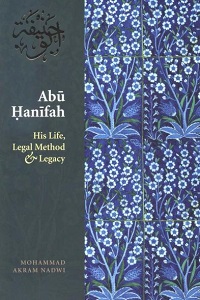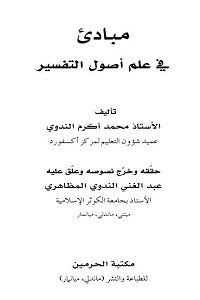Download (5MB)
About this book
As Muslim peoples begin to waken from this dark period of their history, and wonder how to express their religion in the modern world, it is particularly important to reflect upon what the authority of the law means. In what does it consist? How can it be recognized? The sources tell us that, not long after his death, people in the Islamic world referred to Abū Hanifah as ‘al-imam al-a zam’, meaning ‘the greatest one worthy to be followed’. In this essay I try to understand how and why he came to deserve that title. It is especially important to do so at this time, for two reasons:
First, there are increasingly strident calls for reform of Islamic ways of life (coming from non-Muslims, which is to be expected, and also from Muslims themselves). Even if the call for reform is well-meant, often its rationale neither begins nor ends in the Qur’an and Sunnah. Rather, the proposed reform is often concerned to ‘face up to modern realities’ and to adopt norms and values that have appealed to peoples who have no grounding in Islam at all or have rejected it. Accordingly, Qur’an or Sunnah even though both are presented by God as His special mercy for human beings – are considered as a nuisance, an obstacle, that somehow the reform must talk its way around. Without saying it out loud, proposed reforms of this kind must strongly wish that Qur’an and Sunnah did not exist or did not have any hold on the hearts and minds of Muslims. By contrast, Abū Hanifah and the other great imams of the law got their intellectual energy and inventiveness from, and used it within, the boundaries of Qur’an and Sunnah. Their consistent aim was to help Muslims fulfil their rights and duties to God and to each other, not to evade those rights and duties. For example, many of the tools of ‘capitalism’ as it is now called, which supported the great expansion of trade and com- merce during the high period of Islamic history, were constructed by jurists Hanafis prominent among them, notably in some works attributed to Muhammad ibn al-Hasan al-Shaybanī in the form of conscientiously designed contracts that enabled entrepreneurs to extend and exchange credit within the bounds set by God, to strive for profit and avoid usury and other financial and commercial crimes. How different the ‘capitalism’, and how different its outcomes, when the conscience informing it was neither inspired, nor restrained, by the moral and methodological boundaries of the Qur’an and Sunnah! (The material is technical and demands a great deal of detailed discus- sion not suited to an introductory essay; however, the economic ethics of Hanafi figh is a subject that urgently needs to be presented to the general reading public, Muslims especially.)
Second, the proliferation of words and images through the modern means of communication has made it possible to circulate ideas and opinions of all kinds in great volume at great speed. That combination results in strong, but often short-lived, influence that is, it results in changing immediate ‘moods’ and ‘attitudes’, not the structures and habits that underlie more stable and enduring behaviour. Insofar as Islamic law is connected to faith and religion, reflections upon it are properly suited to slow, textual scholarship, not to high-impact soundbites and images that TV and Internet output demand. Also, Muslims should think carefully about the provenance of the ideas and opinions that are offered to them, not always anonymously, yet almost always from very far away: we can know what someone says, but we cannot know how they live. Put bluntly, a non-Muslim, just as well as a Muslim, could read up the texts on a standard alim’s reading list, and if energetic and articulate enough, present (on the basis of their reading) moral advice and legal opinions that appear to be as Islamically argued’ as the established ways: they may well be so argued; equally, they may not. In this essay, I have emphasized (just as traditional Islamic scholar- ship always has) the information we hold about who Abū Hanifah studied with and where, and what kind of man he was, how he lived his life in relation with God and fellow human beings. In his own time, his peers and contemporaries were concerned, and for the best of reasons, just as we now should be, to find out about his background and his backers, to find out if his intellectual brilliance, his breadth of learning, his intelligence and personal charms were complemented by his piety and righteousness. I have tried here to present an account of his life, his legal method and his legacy, in a way that I hope will add up to an image, a memory, a sense of what kind of Muslim one should look to as a trustworthy source for understanding, adapting, amending the legal foundations of an Islamic way of life.
In the introductory first chapter, I explain the context and back- ground of how the law was placed and expressed in the religion. In Chapter 2, I report the anecdotal material recorded in the sources about the life and character of Abū Hanīfah. I think it fair to say that much of that material (except when it is obviously polemical) is com- memorative. However, it is not therefore unreliable or useless; on the contrary, it is highly relevant to understanding the qualities that are a necessary condition for the authority to pronounce on the law. Chap- ter 3 describes the establishment of the Kufan school, the methodology and characteristics of Abū Hanīfah’s fiqh. Chapter 4 gives an account of some of his major works, and how his tradition was transmitted by his famous students. In Chapter 5, following a recapitulation of Abū Hanifah’s achievement, I give a brief survey of how his legacy evolved through the development of the Hanafi school: this will be difficult for readers new to the subject, because it contains more information than discussion, but I hope it may be useful to those who want to know the principal figures and works of later Hanafi jurisprudence. I have added in a ‘Postscript’ some reflections on the relevance of Abū Hanifah to the present time. Finally, in Chapter 6, I offer a critical account of some of the sources used in the preparation of this essay, followed by suggestions for further reading…….
Mohammad Akram Nadwi
Oxford. April, 2010
فیس بکی دوست باخبر رہنے کے لئے ہمارا فیس بک پیج فالوو کرسکتے ہیں۔ شکریہ۔
Discover more from Best Urdu Books
Subscribe to get the latest posts to your email.

![Fikr e Yunus [Muhammad Yunus Jaunpuri] By Maulana Muhammad Akram Nadwi فکر یونس مولانا محمد یونس جونپوری](https://besturdubooks.net/wp-content/uploads/2023/09/FIKR_E_YUNUS-200x300.jpg)
